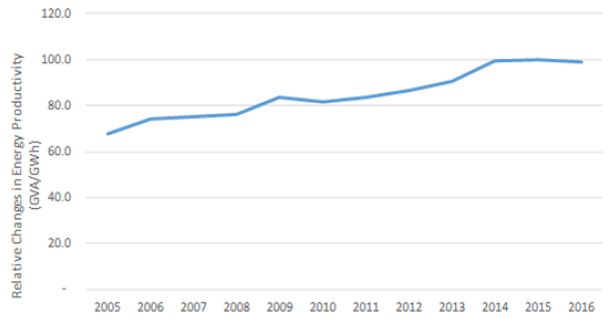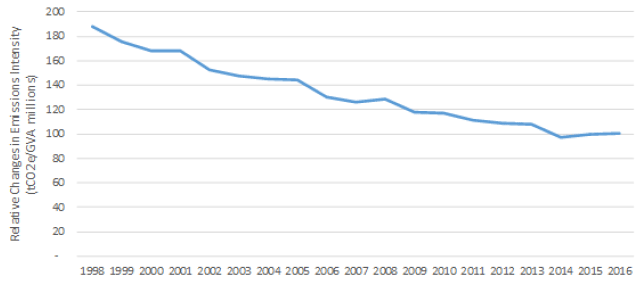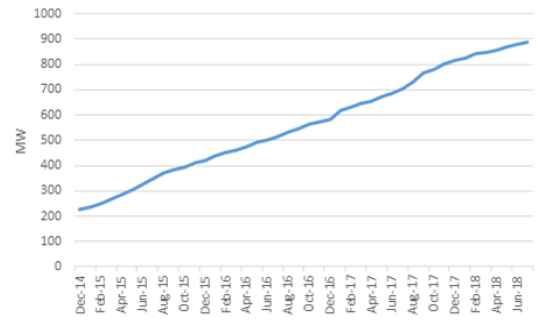Climate Change Plan: monitoring report 2018
The first annual report monitoring progress towards Scotland's Climate Change Plan.
Industry
Greenhouse gas emissions from the industry sector have already been reduced by 48% (1990 to 2016). The Climate Change Plan sets out policies and proposals to reduce emissions from this sector by a further 21% (2018 to 2032) taking the overall reduction in emissions within the sector to 61% when compared with 1990.
The Plan sets out the following three “policy outcomes” for the sector:
1. By 2032, industrial and commercial energy productivity to improve by at least 30% from 2015 levels, through a combination of fuel diversification, energy efficiency improvements and heat recovery.
2. By 2032, industrial and commercial emissions intensity will fall by at least 30%, from 2015 levels, through a combination of fuel diversification, energy efficiency improvements and heat recovery.
3. Technologies critical to further industrial emissions reduction (such as carbon capture and storage, carbon capture and utilisation, and production and injection of hydrogen into the gas grid) are demonstrated at commercial scale by 2030.
Between 1990 and 2016 emissions in the Scottish Industrial sector fell by almost 48%, following a slight (0.7%) increase in emissions in the sector in 2016.
The Scottish Government is working to coordinate incentive mechanisms on energy efficiency and decarbonisation measures across industry. We are developing a discussion paper to be shared with industrial stakeholders that will contain options on further incentives and business support, reflecting our commitment to manage the transition toward decarbonising the industrial sector.
As outlined in the Climate Change Plan, the Scottish Government has developed measures which recognise the importance of sustainable economic growth as Scotland’s industrial sector strives to remain internationally competitive, avoiding carbon leakage, whilst reducing emissions and energy use.
Energy productivity and emissions intensity in the industrial and commercial sectors in Scotland have been introduced as measures to demonstrate that over the long-run, for each unit of energy input, we are achieving higher levels of output, and for each unit of output, we are generating fewer greenhouse gas emissions.
Between 2015 and 2016, energy productivity in the industrial and commercial sectors in Scotland decreased by 1%. This is the first decrease since 2010, and can be attributed to an increase in energy consumption in these sectors over the period. This period also saw a slight increase in emissions intensity, primarily because of an increase in emissions across both industry and services.
There has been a general trend of increasing energy productivity and decreasing emissions intensity in the industrial and commercial sectors in Scotland in recent years, demonstrating progress with the measures.
Overall however, the decrease in energy productivity and increase in emissions intensity between 2015 and 2016 contrasts with continued long-term progress made on these measures, as detailed in the sections below. It is anticipated that future decreases in emissions and energy consumption and increases in output in these sectors will lead to a fall in emissions intensity and energy productivity as per the ambitions set out in the Climate Change Plan.
Output Indicator For Policy Outcome 1:
Industrial and commercial energy productivity to improve by at least 30% by 2032.
| Year | 2020 | 2025 | 2032 |
|---|---|---|---|
| Change in Energy productivity from 2015 | 10% | 20% | 30% |
Most Recent Data: £2.20 million GVA per GWh energy productivity in 2016.
Baseline Data: £2.23 million GVA per GWh energy productivity in 2015.
Change: 1.3% decrease in energy productivity from 2015 to 2016.
Data Source(S):
- Quarterly National Accounts Scotland, Q1 2018[1].
- Total final energy consumption at regional and local authority level[2].
On Track: Too early to make assessment.
Commentary:
- Between 2005 and 2016 energy productivity in the industrial and commercial sectors in Scotland rose by 45% as a result of an underlying 25% fall in energy consumption and a 9% increase in GVA (2016 prices) during this time.
- Energy productivity fell 1.3% between 2015 and 2016, which is the first decrease in this measure since 2010, and which follows steady increases since 2005, as outlined in Industry Figure 1. The reduction in this period was largely due to increases in energy consumption in 2016, the first increases in consumption in these sectors since 2010, coupled with moderate levels of growth in output.
Industry Figure 1: Relative Changes in Energy Productivity (GVA/GWh), 2005 to 2016 (2015 = 100)

Output Indicator For Policy Outcome 2:
Industrial and commercial emissions intensity to fall by at least 30% by 2032.
| Year | 2020 | 2025 | 2032 |
|---|---|---|---|
| Change in emissions intensity from 2015 | -10% | -20% | -30% |
Most Recent Data: 113.2tCO2e per £1 million GVA, in 2016.
Baseline Data: 112.9tCO2e per £1 million GVA, in 2015.
Change: 0.3% increase in emissions intensity from 2015 to 2016.
Data Source(s):
- Scottish Greenhouse Gas Emissions, 2016 - Climate Change Plan Sectors Paper[3].
- Quarterly National Accounts Scotland, Q1 2018[1].
On Track: Too early to make assessment.
Commentary:
- Between 1998 and 2016 emissions intensity fell by 47%, as a result of an underlying 32% fall in emissions and a 28% increase in Gross Value Added (GVA) (2016 prices). The majority of the reduction in emissions during this period came from industry (over 6MtCO2e, a 37% fall) rather than services (0.2MtCO2e, a 5% fall).
- Emissions intensity increased by 0.3% between 2015 and 2016, driven by an increase in emissions across both industry and services and a moderate increase in GVA. Despite this increase, the sectors are following an overarching trend of decreasing emissions intensity, as outlined in Industry Figure 2, and at this stage it remains too early to make an assessment as to whether this long-term indicator is on track.
Industry Figure 2: Relative Changes in Emissions Intensity (tCO2e/£ millions), 1998-2016 (2015=100)

Implementation Indicator For Policy Outcomes 1, 2 And 3:
The installed capacity of renewable heat receiving payment under the non-domestic Renewable Heat Incentive (RHI) increases.
Most Recent Data: 892MW of installed capacity receiving payment under the non-domestic RHI in August 2018.
Baseline Data: 729MW of installed capacity receiving payment under the non-domestic RHI in August 2017.
Change: 163MW (22%) increase in installed capacity of renewable heat receiving payment under the non-domestic RHI from August 2017 to August 2018.
Data Source(s): Renewable Heat Incentive statistics, Department for Business, Energy and Industrial Strategy[4].
Commentary:
- Installed capacity of renewable heat receiving payment under the non-domestic RHI has increased by 112% since December 2015, as outlined in Industry Figure 3.
Industry Figure 3: Installed capacity of accredited non-domestic installations (MW)

- RHI incentivises renewable heat generation. Increasing the proportion of heat generated renewably will therefore reduce the emissions intensity of heat consumption in Scotland.
- Scotland currently accounts for 21% of all non-domestic accredited installed capacity to the RHI scheme as of August 2018.
- It should be noted that this does not give the full picture of non-domestic renewable installations, only those who have joined the RHI scheme. However, it can be assumed this covers the majority, as the RHI provides an incentive to install renewables.
Implementation Indicator For Policy Outcomes 1, 2 And 3:
Improve the evidence base of the industrial sector in Scotland through initiatives under the Manufacturing Action Plan and SEEP (Scotland’s Energy Efficiency Programme).
Most Recent Information: The Scottish Government continues to work alongside Industry representatives and agencies including the Scottish Environmental Protection Agency, Resource Efficient Scotland and Zero Waste Scotland to improve the evidence base of the Scottish Industrial Sector.
Information Source(S):
- Scottish Environment Protection Agency: Scottish Pollutant Release Inventory[5].
- European Environment Agency Database on emissions and energy use for Large Combustion Plants[6].
Commentary:
- The Scottish Government is working alongside industrial and sector stakeholders to improve the evidence base on emissions and energy use across the Scottish Industrial sector. This information should support industry to be more productive and decarbonise, and should also be of use to benchmark the performance of industrial operations.
- Industrial stakeholder workshops, hosted regularly following the Ministerial Roundtable at the end of 2017, have been significant in developing our understanding of the Scottish industrial sector. These forums have provided insight into the challenges and opportunities industry faces to meet the targets that we have set.
- We have achieved positive engagement with Scottish energy intensive industries over the past year, creating a platform from which to move into a collaborative phase of working partnership with industry to make inroads into climate targets.
- The information sources listed above provide historical emissions and energy use data at the individual site level, which, due to the levels of categorisation within the datasets, can be aggregated to sub-sector and sector levels. This has allowed for detailed analysis of the trends in industrial emissions over time.
Implementation Indicator For Policy Outcomes 1, 2 And 3:
Continued annual monitoring of energy productivity and emissions intensity.
Most Recent Information: As above.
Information Source(s): As above[5, 6].
Commentary:
- The annual monitoring commitment of this implementation indicator is informing the reporting period for the output indicators for policy outcomes 1 and 2.
- Implementation Indicator For Policy Outcomes 1, 2 And 3:
- The Scottish Government funded elements of the ACORN Carbon Capture Utilisation & Storage (CCUS) Project feasibility study are completed by November 2018.
- Most Recent Information: The Scottish Government funded elements of the ACORN CCUS project are on track to be completed by mid- November 2018.
- Information Source(S): Project promoters - Pale Blue Energy Ltd[7].
- Commentary:
- There is international recognition that we need CCUS to meet global climate change ambitions agreed in Paris in 2015. Scotland is uniquely blessed with existing infrastructure that could be adapted for use in CCUS and we have unique access to vast CO2 storage potential and the Scottish Government has consistently supported the calls for investment in Carbon Capture and Storage and CCUS projects.
- The UK Government are currently undertaking a major programme of activities to develop their policy on CCUS – interest in CCUS is growing in UK Government and is increasingly linked to hydrogen production. Scottish Government are closely involved in the progress of UK policy on CCUS.
- The ACORN CCUS project, which has received direct financial support from the Scottish Government, was also recently awarded a circa £1 million grant from EU funding streams as a Project of Common Interest. This grant will further cement the ACORN project’s status as the most advanced CCUS project in the UK.
Contact
Email: Decarbonisation Division
There is a problem
Thanks for your feedback